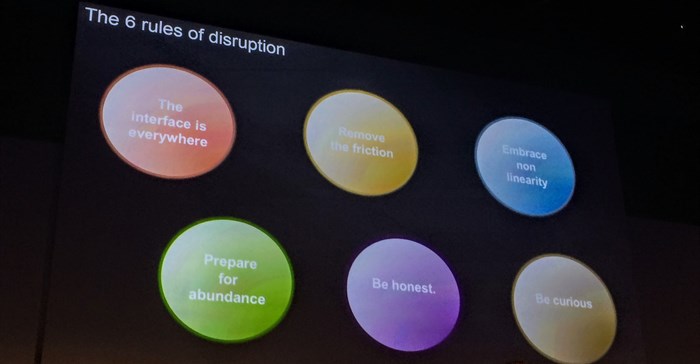
Top stories




Marketing & MediaCammy Msimango on finding her footing in South Africa’s fast-moving digital newsroom
Esther Tomorrow, MDNTV 1 day



Moulton shared the six rules of disruption that he and the editor of Wired Magazine in the UK put together (which, due to the fast-changing pace of technology, are often updated).
"Stuff that seems like science-fiction is here now,” says Moulton. “If we think about it in the right way, it’s actually quite profound."

The interface between man and machine has historically been a keyboard. With the introduction of smartphones and tablets, however, the interface has changed to one of touch and swipe.
Then about 18 months ago, Apple made a very significant interface change - Siri. We now talk to our devices and Siri is but one example of the multiple voice interfaces we now have at our disposal. He says that while we are in the process of developing apps for our smart devices, we should think about the human voice and the developments that are going on in that regard.

A number of organisations that are going through digital transformation are doing so because their competitors are easier to do business with than they are. These organisations have cracked the code of simplicity; they’ve removed the friction between what they have and what the consumer needs.
As a general principle, Moulton says that we should be removing the friction at every opportunity we get: "Think about what happens when you get a part of your business process and turn it into software that goes onto your smart device. You are redefining the consumer experience of that service. The complexity that sits behind it might be massive - but the experience the user has is simple."
"For those of you who are feeling challenged by software startups, the fundamental one is one of simplicity. We need to use these opportunities we have in front of us when we go through these transformations of making whatever we have to offer easier to consume. Remove the friction externally for your customers, and internally for your own employees," he explains.
According to Moulton, we are going to have to get familiar with non-linearity.
"Some of you have been to conferences where the keynote speaker will say something like 'there will be 200 billion connected devices by the year 2020'. I’m not interested in the number of connected devices because they will get it wrong. What I’m interested in is the relationship between the signal and the noise that those connected devices will generate.”
He used fitness trackers as an example - a consumer device which monitors one's heart rate. "There are hundreds and thousands of people wearing these devices which are all sending data and generating noise. But out of this noise, I have to find the signal because the signal is the business process."
He says that we need to have algorithmic and data science approaches to how we figure out finding the signal that is buried in all of the noise.
"We need to embrace non-linearity. We’re very good at straight lines, we’re not very good at exponential curves. We now have critical mass, and when we have critical mass, things fundamentally change."
Things that used to be scarce now become abundant.
"Take for example the 35mm camera and film. The number of pictures I could take used to be dependent on the amount of film I had - and film was expensive because it was a chemical process. You then 'indexed' them according to time, date and location. Now we carry high definition still and video cameras in our pockets. The marginal cost of taking a picture is now zero because the cost of taking one picture is the same as taking 1000 pictures," he says.
So what’s the problem then? We can’t find anything.
"We might have 6000 images stored in various locations such as the cloud, on a device, or on an external hard drive, which means we struggle to find the pictures we're looking for," explains Moulton.
In essence, the problem has changed from taking a picture to indexing a picture. Then along came Instagram and Pinterest who solved this indexing problem. He says that when you information-enable something like photography, you fundamentally change what photography is.
It takes about seven years for technological innovations to move from the lab to mainstream. One example he touched on was autonomous vehicles. We’re about one to two years into that seven-year journey.
"Just think about the amount of data these cars will generate. You’re going to need a principle to define the signal from the noise. Look at the industries that you’re involved in - what are the fundamental changes that are happening? Because when you information-enable a technology, you fundamentally change its nature. We’re not going to build that world based on the principles of 20th-century industrial thinking.
"If you look at the history of IT, this is us, I call us the blue curve people. But the world we're moving towards does not look like that at all.

The fact of the matter is that the journey from the blue curve to the green curve is a journey that we all have to go on. We have to use this as an opportunity to educate ourselves and to develop new skills. We need to use this time to fundamentally change the way we orchestrate IT because the blue curve is so radically different to the green curve and it can be difficult to see how these worlds co-exist.
This is the age of Wikileaks. This is the age where you're going to get found out. This is the age where making a mistake in corporate culture and being dishonest has a radical shareholding impact.
"It's of utmost importance to be transparent - with your own people, with shareholders, with the media," he says. "This is a corporate culture that drives governance, that drive compliance and, sometimes, it's in short supply. In all of your dealings, encourage honesty and transparency."
"Read Wired," he says. "See it as an opportunity to educate yourself. Find out how all of this will significantly change the nature of your industry."
"Are you worried about anyone, two, three of these rules? Because I think we need to be," he says.
In order to transform for the future, we need to be thinking about the changing nature of the interface, we need to be removing the friction, we need to be embracing non-linearity, we need to think about the difference between resources that are scarce and those that are abundant, we need to be honest in our day-to-day dealings, and we need to be driven by curiosity.
Best advice of the day from Nigel Moulton @DellEMCSADC #DellEMCForum - Be honest and make sure curiosity drives your day.
— Ryan Noik (@TechTracker) March 9, 2017
